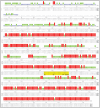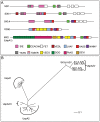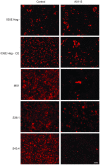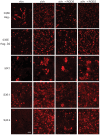A novel group of Moraxella catarrhalis UspA proteins mediates cellular adhesion via CEACAMs and vitronectin
- PMID: 23049802
- PMCID: PMC3458076
- DOI: 10.1371/journal.pone.0045452
A novel group of Moraxella catarrhalis UspA proteins mediates cellular adhesion via CEACAMs and vitronectin
Abstract
Moraxella catarrhalis (Mx) is a common cause of otitis media and exacerbation of chronic obstructive pulmonary disease, an increasing worldwide problem. Surface proteins UspA1 and UspA2 of Mx bind to a number of human receptors and may function in pathogenesis. Genetic recombination events in the pathogen can generate hybrid proteins termed UspA2H. However, whether certain key functions (e.g. UspA1-specific CEACAM binding) can be exchanged between these adhesin families remains unknown. In this study, we have shown that Mx can incorporate the UspA1 CEACAM1-binding region not only into rare UspA1 proteins devoid of CEACAM-binding ability, but also into UspA2 which normally lack this capacity. Further, a screen of Mx isolates revealed the presence of novel UspA2 Variant proteins (UspA2V) in ∼14% of the CEACAM-binding population. We demonstrate that the expression of UspA2/2V with the CEACAM-binding domain enable Mx to bind both to cell surface CEACAMs and to integrins, the latter via vitronectin. Such properties of UspA2/2V have not been reported to date. The studies demonstrate that the UspA family is much more heterogeneous than previously believed and illustrate the in vivo potential for exchange of functional regions between UspA proteins which could convey novel adhesive functions whilst enhancing immune evasion.
Conflict of interest statement
Figures









Similar articles
-
Moraxella catarrhalis binding to host cellular receptors is mediated by sequence-specific determinants not conserved among all UspA1 protein variants.Infect Immun. 2008 Nov;76(11):5322-9. doi: 10.1128/IAI.00572-08. Epub 2008 Aug 4. Infect Immun. 2008. PMID: 18678656 Free PMC article.
-
The UspA1 protein and a second type of UspA2 protein mediate adherence of Moraxella catarrhalis to human epithelial cells in vitro.J Bacteriol. 2000 Mar;182(5):1364-73. doi: 10.1128/JB.182.5.1364-1373.2000. J Bacteriol. 2000. PMID: 10671460 Free PMC article.
-
Impact of sequence diversity in the Moraxella catarrhalis UspA2/UspA2H head domain on vitronectin binding and antigenic variation.Microbes Infect. 2013 May;15(5):375-87. doi: 10.1016/j.micinf.2013.02.004. Epub 2013 Mar 6. Microbes Infect. 2013. PMID: 23474333
-
Virulence determinants of Moraxella catarrhalis: distribution and considerations for vaccine development.Microbiology (Reading). 2017 Oct;163(10):1371-1384. doi: 10.1099/mic.0.000523. Epub 2017 Sep 12. Microbiology (Reading). 2017. PMID: 28893369 Review.
-
MID and UspA1/A2 of the human respiratory pathogen Moraxella catarrhalis, and interactions with the human host as basis for vaccine development.Acta Biochim Pol. 2006;53(3):445-56. Epub 2006 Sep 9. Acta Biochim Pol. 2006. PMID: 16964325 Review.
Cited by
-
Immunogenicity of trimeric autotransporter adhesins and their potential as vaccine targets.Med Microbiol Immunol. 2020 Jun;209(3):243-263. doi: 10.1007/s00430-019-00649-y. Epub 2019 Dec 1. Med Microbiol Immunol. 2020. PMID: 31788746 Free PMC article. Review.
-
Recombination in Bacterial Genomes: Evolutionary Trends.Toxins (Basel). 2023 Sep 12;15(9):568. doi: 10.3390/toxins15090568. Toxins (Basel). 2023. PMID: 37755994 Free PMC article. Review.
-
Utilization of Variant and Fusion Proteins To Functionally Map the Aggregatibacter actinomycetemcomitans Trimeric Autotransporter Protein ApiA.Infect Immun. 2018 Feb 20;86(3):e00697-17. doi: 10.1128/IAI.00697-17. Print 2018 Mar. Infect Immun. 2018. PMID: 29229732 Free PMC article.
-
Molecular screening and dynamics simulation reveal potential phytocompounds in Swertia chirayita targeting the UspA1 protein of Moraxella catarrhalis for COPD therapy.PLoS One. 2025 Feb 28;20(2):e0316275. doi: 10.1371/journal.pone.0316275. eCollection 2025. PLoS One. 2025. PMID: 40019889 Free PMC article.
-
Moraxella catarrhalis adhesin UspA1-derived recombinant fragment rD-7 induces monocyte differentiation to CD14+CD206+ phenotype.PLoS One. 2014 Mar 5;9(3):e90999. doi: 10.1371/journal.pone.0090999. eCollection 2014. PLoS One. 2014. PMID: 24599281 Free PMC article.
References
-
- Murphy TF, Parameswaran GI (2009) Moraxella catarrhalis, a human respiratory tract pathogen. Clin Infect Dis 49: 124–131. - PubMed
-
- Cripps AW, Otczyk DC, Kyd JM (2005) Bacterial otitis media: a vaccine preventable disease? Vaccine 23: 2304–2310. - PubMed
-
- Mannino DM, Buist AS (2007) Global burden of COPD: risk factors, prevalence, and future trends. Lancet 370: 765–773. - PubMed
Publication types
MeSH terms
Substances
Grants and funding
LinkOut - more resources
Full Text Sources
Other Literature Sources
Miscellaneous

